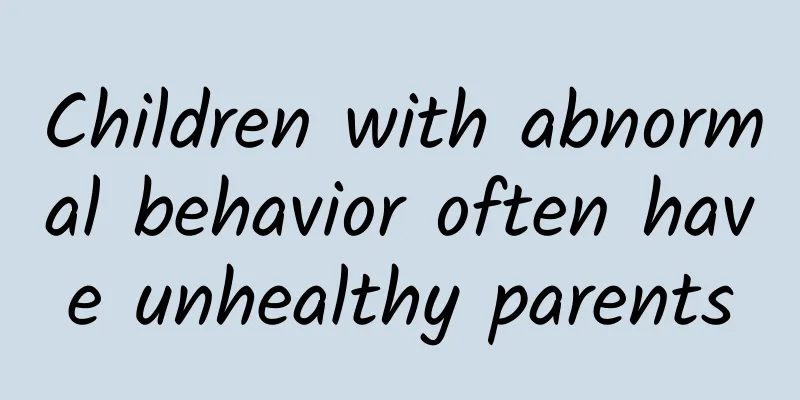Children with abnormal behavior often have unhealthy parents

|
In order to reproduce and pass on from generation to generation, members of nature have populations, and humans have families. As the saying goes, "Children are the mirror of their parents." Children not only look like their parents, but even their behavior is influenced by their parents. If a child has abnormal behavior, it is likely that their parents are unhealthy. Therefore, if a child has problems, the cause should be identified first with the parents. Unhealthy parents are manifested in their physical, psychological, and social aspects. Domestic and foreign studies have confirmed the following points: 1. Harmful factors Various harmful factors during pregnancy and the perinatal period, such as certain serious physical illnesses during pregnancy, especially infection by certain microorganisms or taking certain medications, exposure to certain toxic substances, neonatal hypoxia or asphyxia due to dystocia, various infectious diseases in infancy, especially viral encephalitis, etc., can cause brain damage. The sequelae of mild brain damage may lead to varying degrees of behavioral problems and learning difficulties. 2. Pregnant women’s emotions The emotional changes of pregnant women can affect the fetus through blood and endocrine. Negative emotions of pregnant women, such as sadness, depression, anxiety, worry, sadness, fear, tension, etc., can cause the fetus's cerebral blood vessels to constrict, reduce the blood supply to the brain, thus affecting brain development and increasing the possibility of behavioral diseases in children in the future. 3. Pregnant women smoking Smoking during pregnancy can cause behavioral disorders in children. 4. Heredity and development Intrauterine growth retardation of the fetus, physical maldevelopment of children, and genetics are related to the occurrence of children's behavioral problems. 5. Separation from mother Almost all foster children exhibit some degree of behavioral problems. Foster children experience a process of separation from their loved ones, and the mother-child relationship plays a role in maintaining emotional balance. When separated from their mothers, children attempt to restore their relationship with their mothers; if the separation continues, a grief process will occur, which can easily cause children to become emotionally detached from their parents and establish a relationship of dependency with others. If this process goes smoothly, grief will gradually disappear over time, otherwise bad interpersonal relationships will continue into adulthood. Common behavioral problems among foster children include anxiety, fear, inattention, hyperactivity, and aggression. 6. Family environment The family is the first place where children come into contact with society, and it is also the first classroom for them to learn about social norms and establish behavioral norms; therefore, the family constitutes the most basic and important component of the external environment that influences children's behavior, and it is an important factor affecting children's psychological behavior. 7. Educational methods The ways parents educate their children can generally be divided into loose, strict and persuasive. The first two methods are not conducive to the normal development of children's psychological behavior. If parents physically punish their children, it can significantly increase the possibility of their children engaging in antisocial behavior in the future. Parents should pay more attention to their children's emotional care, pay attention to the way they educate their children, and provide good cognitive stimulation. Educating children with non-violent methods can reduce children's antisocial behavior, thereby achieving the goal of reducing social violence. In loose families, children often do not receive proper guidance from their parents and are prone to behavioral problems. The attitude towards educating children and the way of educating children are closely related. If the parents have inconsistent attitudes towards children's education, it is bound to put the children in an unstable or contradictory educational atmosphere, which will develop into multiple psychological characteristics over time, thus causing personality or behavioral deviations. 8. Parental Relationship The relationships between family members have a subtle influence on the formation of children's psychological character, among which the parent-child relationship has the greatest impact on children's behavior. A stable, harmonious family atmosphere with good morals has a positive effect on cultivating children's good psychological quality and behavior; tension, conflict, and even divorce between parents will increase the probability of children having behavioral problems. Common behavioral problems of such children include anxiety, hyperactivity, antisocial behavior, etc. Children have a strong ability to imitate, and their parents' words and deeds become invisible models for them to emulate; therefore, they should pay attention to their own words and deeds, handle the relationship between family members well, and form a stable and harmonious family. This is the basis for cultivating the all-round and healthy development of children. 9. Parents’ quality The cultural quality of parents determines their own outlook on life, values and morals, which constitute the basis for child rearing. Therefore, the incidence of children's behavioral problems is relatively high in families with low cultural levels of parents. 10. Other factors Parental unemployment, family members breaking the law, parents suffering from serious physical or mental illness (especially maternal depression), and poor parent-child relationships can all increase the possibility of children having behavioral problems, indicating that the important role of the family in the physical and mental growth of children cannot be ignored. Unhealthy family factors of parents lead to abnormal behavior of children, which are intertwined with several processes: 1. Unstable environment Children's behavioral disorders are the result of parents' inappropriate and inconsistent educational methods. In this unstable environment, children learn to establish behavioral patterns that conform to their own wishes and use "aversive behaviors" to change the behavior of others. For example, children cry to subdue their parents, change their attitude and achieve their wishes. Here, "crying" is an abomination. If parents show completely opposite attitudes before and after crying, over time, it will make children establish abnormal behavior patterns, thus causing behavioral deviations. 2. Mental Defense Children cope with adverse family environments by developing a series of internal psychological defense responses. For example, family disharmony and parents' lack of love and care for children can damage children's self-esteem and lead to depression or illegal behavior. 3. Parenting style Improper parenting or incorrect parenting methods have a negative impact on children's behavior. Any behavior that is rewarded will be maintained, regardless of whether the behavior is right or wrong, and regardless of whether the parent's reward is intentional or unintentional. 4. Learning process People learn bad behaviors. Children can learn bad behaviors by observing their parents' behavior patterns. In addition to the unhealthy factors mentioned above, children's own conditions, social psychology, etc. have also been confirmed to be related to abnormal children's behavior: 1. Suffering from disease Children with chronic medical conditions often have behavioral or emotional disturbances. Diseases can affect children in various ways. Some cause pain, some make children anxious, and some make children feel humiliated, isolated, embarrassed and distressed. Most chronic diseases also limit children's daily activities. These may change the attitudes of parents, teachers and peers towards children, thereby causing changes in children's own behavior. Compared with normal children, boys with chronic physical diseases have significantly more behavioral problems such as stuttering, nail biting, and thumb sucking. Most of these children have difficulty concentrating, often make trouble in class, are prone to temper tantrums, and are aggressive. The impact of disease on children's behavioral development is largely related to the restriction of children's activities, because children's behavioral development is achieved through the psychological contradictions generated in activities. This contradiction refers to the contradiction between children's new needs generated by reflecting objective requirements and their original psychological state. Children's activities are the bridge between psychology and objective existence, and are the basis and source of children's behavioral development. 2. Social factors Parents belonging to a lower social class or having a poor social atmosphere can increase the probability of children having behavioral problems. Children's behavior is influenced by social factors through direct contact with society. At the same time, social factors can also act on family members, change the family environment, and thus indirectly affect children's behavior. 3. Environmental pollution Environmental pollution causes elevated blood lead levels in children. Lead is a strong neurotoxin that is widely present in the environment and can cause serious damage to children's neurobehavioral development. Some lead-related neurobehavioral disorders can persist into adolescence. Different children have different causes of abnormal behavior. In short, comprehensive measures should be taken to address the above reasons, avoid the impact of various adverse factors on children's psychological behavior, reduce the occurrence of children's behavioral problems, and enable children to develop comprehensively and healthily, which in turn promotes family happiness and achieves the harmonious unity of man and nature. |
>>: Yujian Science Popularization丨How to use "shady" drugs
Recommend
Can Fuyankang Tablets treat fungus?
Every summer I have to toss and turn. When I was ...
Why do I keep coughing after catching a cold?
Coughing during illness helps protect the lungs f...
Does walking speed affect health? It's really good to stick to this walking speed
Walking is something we do every day It is also o...
Causes of miscarriage due to endometriosis
For women, the most troublesome disease is gyneco...
The hairy part of the pubic area is itchy
Nowadays, many people find that the hairy parts o...
Unobstructed vaginal ultrasound examination pictures
Many female friends are scared and embarrassed wh...
What disease is itchy nipples a precursor to?
Many people have experienced nipple itching. Gene...
What is the reason for the yellow leucorrhea after miscarriage?
For women, it is normal to have leucorrhea. The m...
Onavo: Twitter is only 60% of Instagram on the US iPhone platform
Twitter is only 60% of Instagram on the iPhone in ...
What is the structure of the female vagina?
The female genitals are the most mysterious place...
Can esophageal cancer be removed as early as possible under endoscopy? The following conditions must be met
Author: Wu Qi, Chief Physician, Peking University...
After being discharged from the hospital after laryngeal cancer surgery, what issues should be paid attention to in daily care?
Author: Liu Yongling, deputy chief nurse, Beijing...
The most comprehensive analysis to date! Antibiotic resistance-related deaths have become the third leading cause of death worldwide
Written by: Zhu Hengheng Editor: Wang Haha Since ...
How to remove Sichuan character lines
The 川-shaped lines are mainly a common facial exp...









